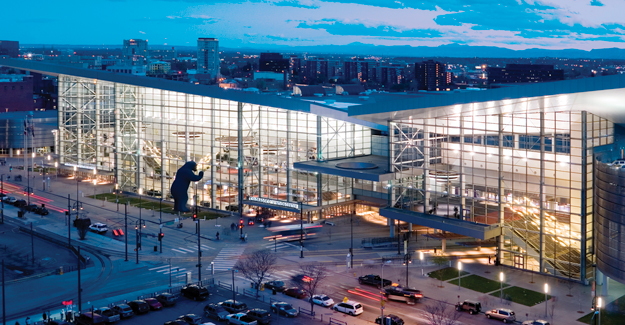
Operation: Colorado Convention Center
Location: Denver, Colorado
Space Being Cleaned: 2.2-million square feet
Employees: 300 full-time employees, as well as part-time workers and temporary workers.
Certification: LEED-EB (existing buildings) from U.S. Green Building Council
Date of Certification: May 2010
Last year the Colorado Convention Center, in Denver, made national headlines as one of the largest LEED-certified buildings in the world. The 2.2-million square-foot structure received LEED for Existing Buildings (LEED-EB) certification from the U.S. Green Building Council after undergoing an 18-month-long certification process that resulted in reduced energy and water consumption, a 26-percent reduction in carbon emissions and a green cleaning program.
"Our entire sustainability program actually originated in our custodial department," says Lindsay Arrell, sustainability programs manager for the convention center. In fact, the cleaning operation began using green chemicals and equipment, and paper with recycled content long before the LEED process officially began. "We saw LEED certification as a way to help organize our process."
Since becoming certified, the facility has diverted 50 percent of all waste from landfills, recycled 100 percent of all durable goods, purchased sustainable products for more than 30 percent of all consumables and has continued to expand the green cleaning program.
The changes made to achieve LEED certification is expected to save the city millions in operating costs and further enhance Denver's reputation as a healthy and desirable destination for conventions and events.
"Overall the sustainability program has earned us recognition in the industry as being a leader in sustainability," says Arrell, noting some clients host their events at the center because of the certification and still others come to them for advice in their own LEED-EB certification efforts.
The first step toward certification was communicating the desire to become more sustainable to suppliers. Facility executives presented the direction they were hoping to head with green initiatives and that they needed help from distributors and suppliers to get there.
To earn certification credits, the center added a sustainable purchasing policy, moved to reduce waste through recycling and the use of post-consumer products, developed a green cleaning policy, worked to reduce greenhouse gas emissions, and reduced its water consumption.
The process also required the development of new standard operating procedures and employee schooling. For instance, the number of cleaning products used by custodial workers dropped dramatically. But the fact that the chemicals were not as harsh and did not smell "clean" required education.
"LEED also looks at the health and comfort of employees, which required us to look at indoor air quality (IAQ) and reducing airborne particles," Arrell says. Vacuums with advanced HEPA filtration and reduced decibel outputs helped the center improve IAQ.
"We've simplified our processes and it's really the direction the industry is heading, so we are responding to our clients," Arrell says. "By reducing our environmental footprint, we improve the environment too."
To others hoping to achieve LEED-EB certification, Arrell offers up the following advice: "Work with your vendors and let them help. Tell them this is a goal you're trying to meet. If the technology isn't here yet for something, you don't need to change it now, come back to it later. It's an evolving process and a partnership with everyone involved."
Click here to read profiles on facilities that have qualified for certifications such as GS-33, CIMS and (OS1).
Ronnie Garrett is a freelance writer based in Fort Atkinson, Wis.

 The Down and Dirty on Cleaning in Virus Season
The Down and Dirty on Cleaning in Virus Season How Surfactant Use is Expanding in Commercial Cleaning
How Surfactant Use is Expanding in Commercial Cleaning Maximize Your Margins: Learn How to Automate Pricing and Track Rebates
Maximize Your Margins: Learn How to Automate Pricing and Track Rebates